‘Exquisite Roman hand’; a humanist Psalter c.1460 by Pietro Ursuleo of Capuo in Latin.
£12,000.00
Large remnant of the Psalter with Passion Sequences copied by Pietro Ursuleo of Capuo, in Latin, illuminated manuscript on parchment, 30 leaves, remains of three gatherings and a number of bifolia and single leaves, bound tightly and with numerous repairs to gutters, hence uncollatable (but see below), single column of 19 lines of the fine and accomplished humanist hand of Pietro Ursuleo (described by M.R. James from the sister volume as ‘an exquisite Roman hand’: Western Manuscripts in the Library of Trinity College, Cambridge, 1902, III, no. 1374, p. 384), faded red rubrics, dark blue and liquid gold capitals, 32 illuminated initials enclosed within white vinework on blue, green and red grounds, last word of Matt. 52 at end of text erased, some stains and losses at edges (probably from water damage during ownership by Jarman, see below), edges repaired with more modern parchment and edges of one or two initials restored, a few leaves with ink faded or partly flaked away, one page overwritten to correct this, with edges of some letters stretching over repair parchment of missing borders (fol. 9r here), overall presentable condition, 171 by 26mm., blue cloth covered boards with green leather spine (bound for J.H.P. Pafford: see below), ‘MS’ and ‘SAEC XV’ in gilt on spine, 4to, [southern Italy (Naples)], [c.1460].
Provenance:
- Written by the scribe Pietro Ursuleo (d. 1483), bishop of Satarino and elevated on his deathbed to the archbishopric of Santa Severina, and perhaps illuminated by Matteo Felice or a member of his workshop, as one of two sister volumes (the other now Trinity College, Cambridge, MS O.7.46) for a patron in Ravenna.
- The parent volume was most probably then in the collection of John Boykett Jarman (d. 1864), and damaged by the flood that affected his manuscript collection (the parent manuscript was his sale in Sotheby’s, 13 June 1864, lot 161).
- By January 1912 it had passed to the London bookseller James Tregaskis (1850-1926), who offered it intact in his cat. 717 (8 January 1912), no. 485 (and again in cat. 720, perhaps March 1912, no. 571; and cat. 743, 1913, no. 510; at which point it contained 169 leaves), but when it went unsold began to remove single leaves for sale (see his cat. 777, 1916, no. 81, 4 leaves). Leaves from it are now widely dispersed, with lists in M. Manion, V.F. Vines and C. de Hamel., Medieval and Renaissance Manuscripts in New Zealand Collections, 1989, no. 89, Peter Kidd’s blogpost of 2014 and the Fragmentarium website.
- J.H.P. Pafford (1900-96), Goldsmith’s Librarian of University College, London, and a prolific text editor and author, who recorded in correspondence with A.C. de la Mare in 1979 that he purchased these 30 leaves in two equal blocks, only a week or two apart in about 1962, from The Guildhall Bookshop of Twickenham and from ‘a bookshop in the Bloomsbury area … a newly opened shop’. Tregaskis’ business was carried on by family members until 1939, and the parent volume seems to have passed to a member of the book trade by the late 1950s, who divided it up into short sections and dispersed these into the London trade. Manion, Vines and de Hamel note that two sections appeared on the market in the late 1950s, while 28 leaves appeared at Sotheby’s, 11 July 1960, lot 153, and 22 leaves were Alan G. Thomas, cat. 14 (1964), no. 22. The Sotheby’s and Thomas sections appear to have been divided and dispersed by the Folio Fine Art Society, and this group here may well be the last substantial remnant of this alluring codex to remain together. By descent from Pafford to the present owner.
- Appeared at Drewatts sale 6 July, 2021 Lot 135 with a pre-sale estimate of £10,000 – £15,000.
Text: The leaves here contain: fols. 1-6: Psalms 6:4-14:1-4; fols. 7-8: Psalms 16:4-17: 24; fols. 9-10: Psalms 31:3-33:10; fols. 11-15: Psalms 33:11-34:27, 35:1-37:9; fols. 16-18: Psalms 38:4-41:7; fol. 19: Psalms 72:9-73:3; fols. 20-21: Psalms 106:19-108:8; fol. 22: Psalms 110:9-113: 2; fol. 23: Psalms 143:14-144:19; fol. 24: Psalms 148:9-150, followed by part of the Canticle (the opening of the Song of Isaiah, here 12:1) and Is. 12:2-end, followed by Is. 38:9-18 on fol. 25; fol. 26: Canticles (the Prayer of Habakkuk, here 3:11-end, followed by the Song of Moses, here Deut. 32:1-7, with Deut. 32:7-38 continuing on fols 27-28; fol. 29: Te Deum (ending), Gloria (opening); and fol. 30: Matt. 27:52-end, with last word erased.
Be the first to review “‘Exquisite Roman hand’; a humanist Psalter c.1460 by Pietro Ursuleo of Capuo in Latin.” Cancel reply
Product Enquiry
Related products
C14th -C16th manuscripts
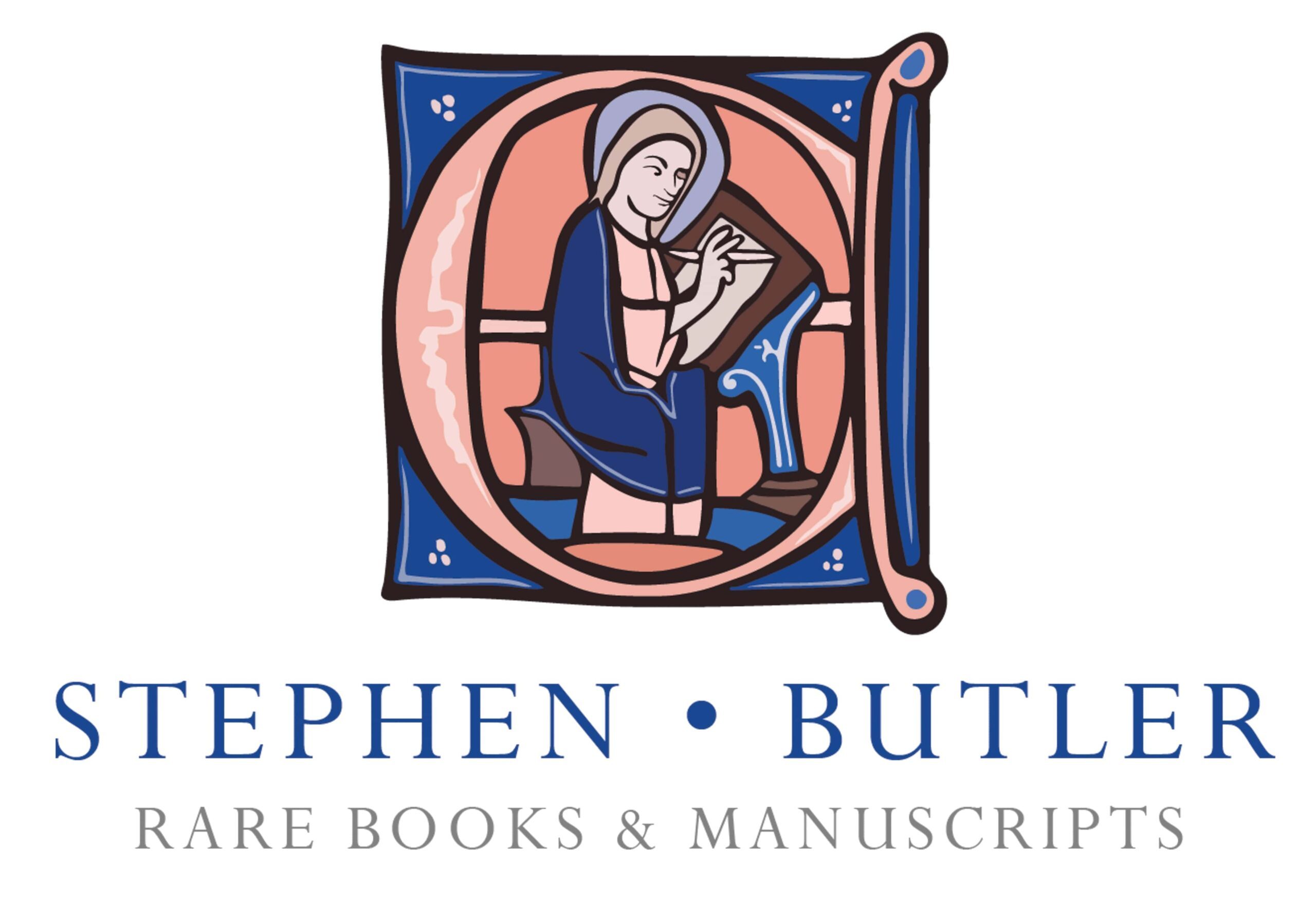


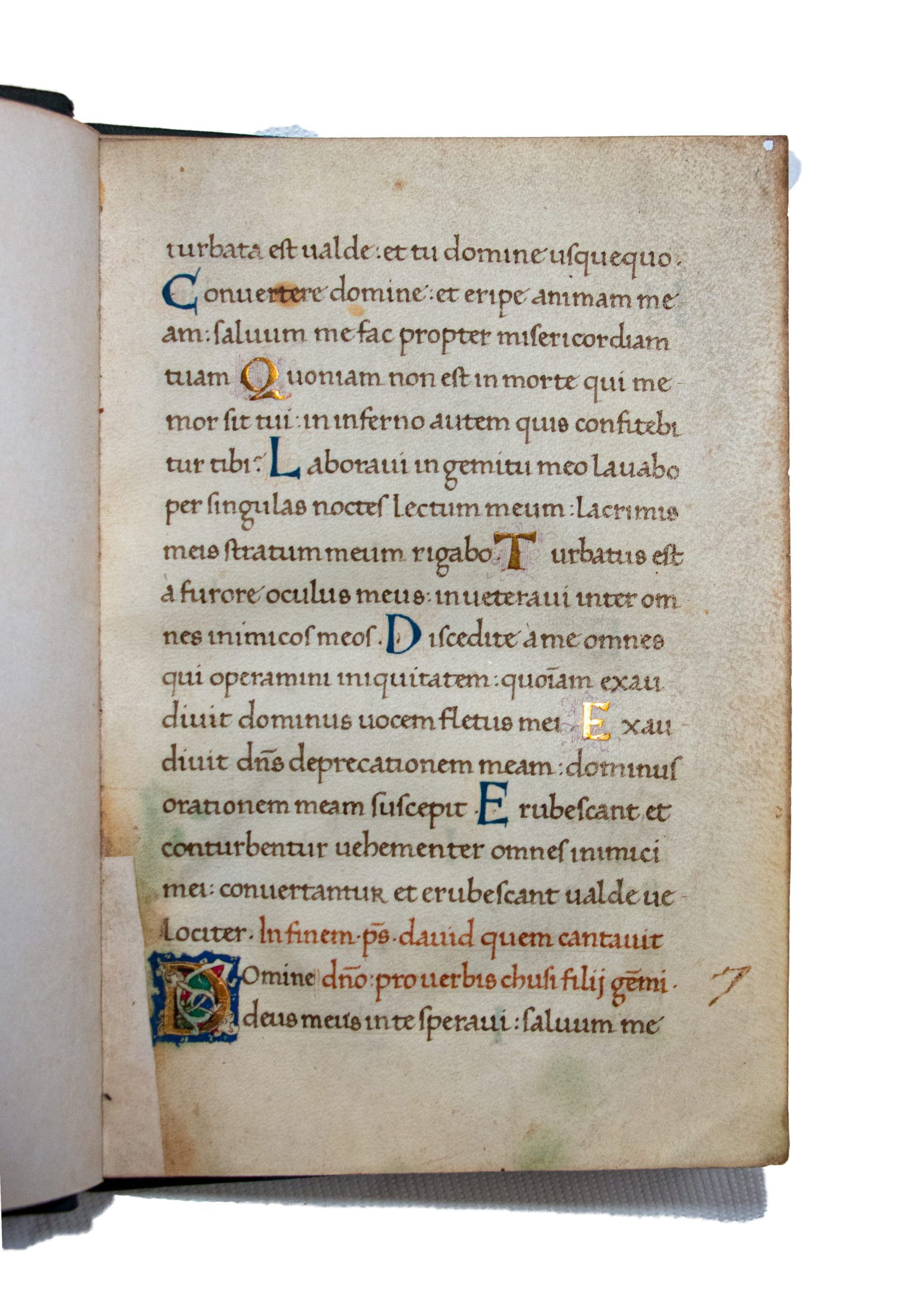




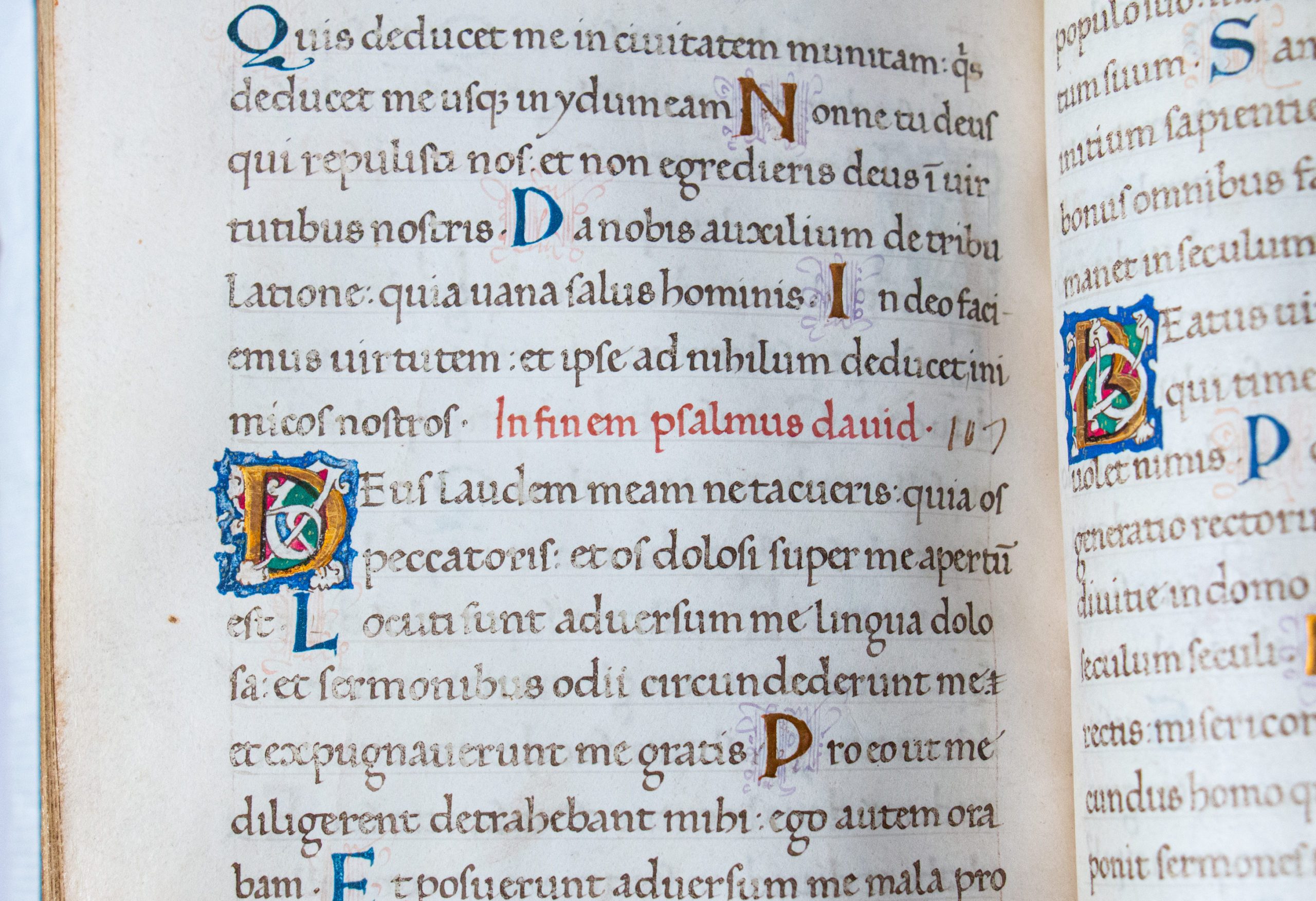












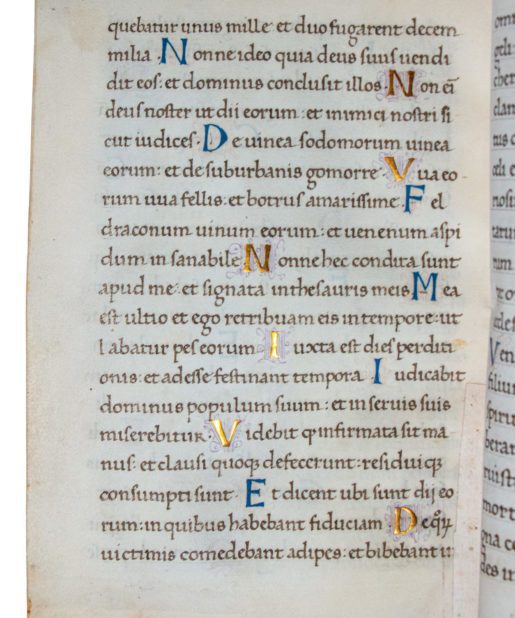



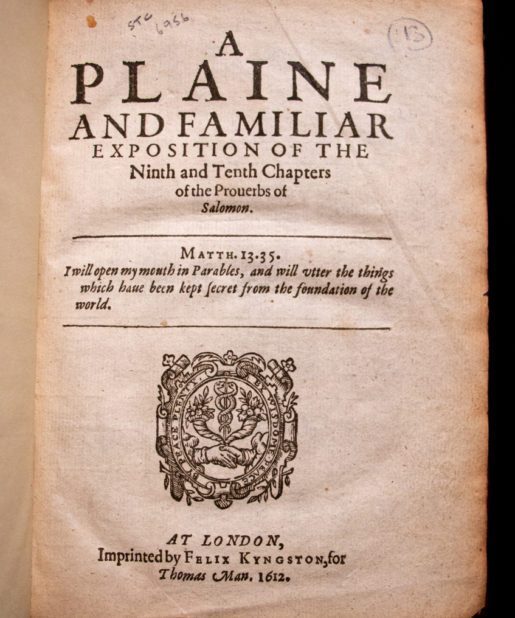



![Jonah Kneeling in Prayer Before God on a bifolium from a Bible in Latin [Northern Spain (diocese of Álava?), late 13th or early 14th century] Jonah Kneeling in Prayer Before God on a bifolium from a Bible in Latin [Northern Spain (diocese of Álava?), late 13th or early 14th century]](https://butlerrarebooks.co.uk/wp-content/uploads/2021/12/57A4063-scaled-515x618.jpg)
![Jonah Kneeling in Prayer Before God on a bifolium from a Bible in Latin [Northern Spain (diocese of Álava?), late 13th or early 14th century] Jonah Kneeling in Prayer Before God on a bifolium from a Bible in Latin [Northern Spain (diocese of Álava?), late 13th or early 14th century]](https://butlerrarebooks.co.uk/wp-content/uploads/2021/12/57A4056-2-515x618.jpg)


![A single leaf; Augustine’s Enarrationes in Psalmos, for Psalm 41:6-8 [manuscript] A single leaf; Augustine’s Enarrationes in Psalmos, for Psalm 41:6-8 [manuscript]](https://butlerrarebooks.co.uk/wp-content/uploads/2021/06/IMG_2115-scaled-515x618.jpg)
![A single leaf; Augustine’s Enarrationes in Psalmos, for Psalm 41:6-8 [manuscript] A single leaf; Augustine’s Enarrationes in Psalmos, for Psalm 41:6-8 [manuscript]](https://butlerrarebooks.co.uk/wp-content/uploads/2021/06/IMG_2112-scaled-515x618.jpg)


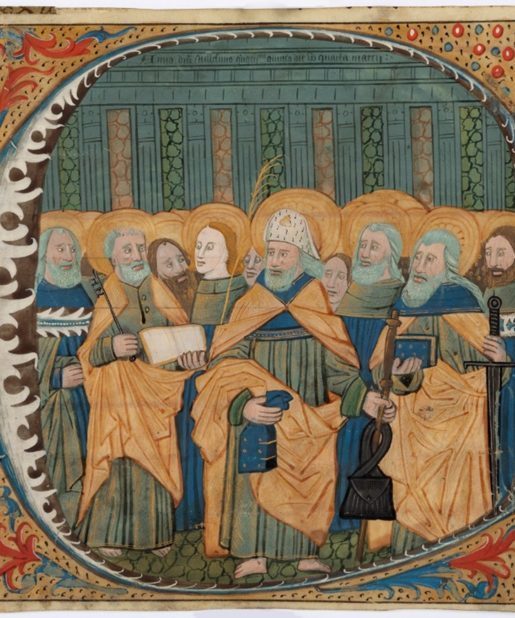
![Two fragments from Raymond of Penyafort (d. 1275), Summa de casibus penitentialis and Summa de matrimonio [Italy (or southern France?), 14th century] Two fragments from Raymond of Penyafort (d. 1275), Summa de casibus penitentialis and Summa de matrimonio [Italy (or southern France?), 14th century]](https://butlerrarebooks.co.uk/wp-content/uploads/2023/07/IMG_0096-515x618.jpg)
![Two fragments from Raymond of Penyafort (d. 1275), Summa de casibus penitentialis and Summa de matrimonio [Italy (or southern France?), 14th century] Two fragments from Raymond of Penyafort (d. 1275), Summa de casibus penitentialis and Summa de matrimonio [Italy (or southern France?), 14th century]](https://butlerrarebooks.co.uk/wp-content/uploads/2023/07/IMG_0095-492x618.jpg)
Reviews
There are no reviews yet.